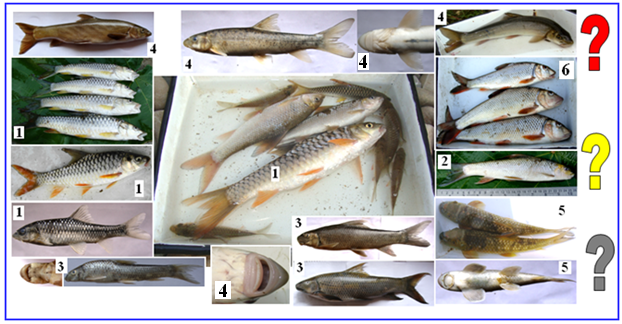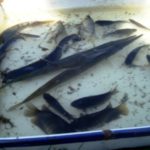Sort out fish(es) with elongated cylindrical or compressed body with long caudal peduncle, deeply forked caudal fin, very large (somewhat hexagonal) to small scales, orange or yellowish or pinkish hue on the fins, shining silvery to dull grey or brown shades, etc.:
…….. place them in one lot collectively labeled as Minnows or Minor
Carps or Mahseers or Suckerfish etc, as numbered 1 – 5 in assemblage below.
[Being more fish samples involved; Segregation of Lot 12, is made available in 2 Parts,
PART I
&
PART II]
The sorting of some fishes in the field was made on the basis of the elongated, cylindrical or compressed body with long caudal peduncle, deeply forked caudal fin, very large (somewhat hexagonal) to very small scales, orange or yellowish or pinkish hue on the fins, shining silvery to dull grey-black or brown shades etc.
They were placed under Lot 12, collectively labeled as Minnows or Minor Carps or Mahseers or Suckerfish and numbered 1 to 6 in the assemblage as shown in the photograph below.

The criteria decided in the field for segregation of genera/species of Lot-12, represented by the individuals numbered 1 – 6 [in the photograph above] are as shown in the TABLE below:

SEGREGATION OF GENUS/SPECIES BASED ON THE CRITERIA DECIDED IN THE FIELD FOR THE SAMPLE INDIVIDUALS
Lot 12: PART – I
No. 12.1 – 12.3.
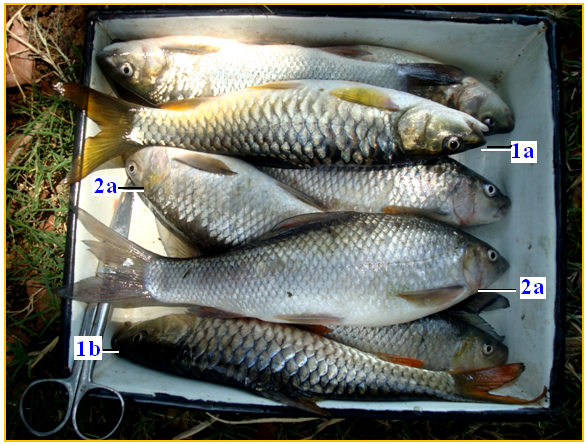
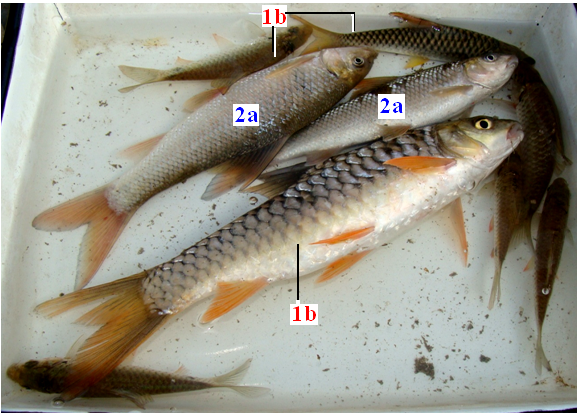
1
The individuals having shiny and largest hexagonal scales (among the whole lot), with parallel striae and dark bases; lemon yellow or orange-red fins and blackish-grey silver colouration of body are identified here, belonging to Genus Tor [Family – Cyprinidae; Minnows or Carps], commonly called as Mahseers.
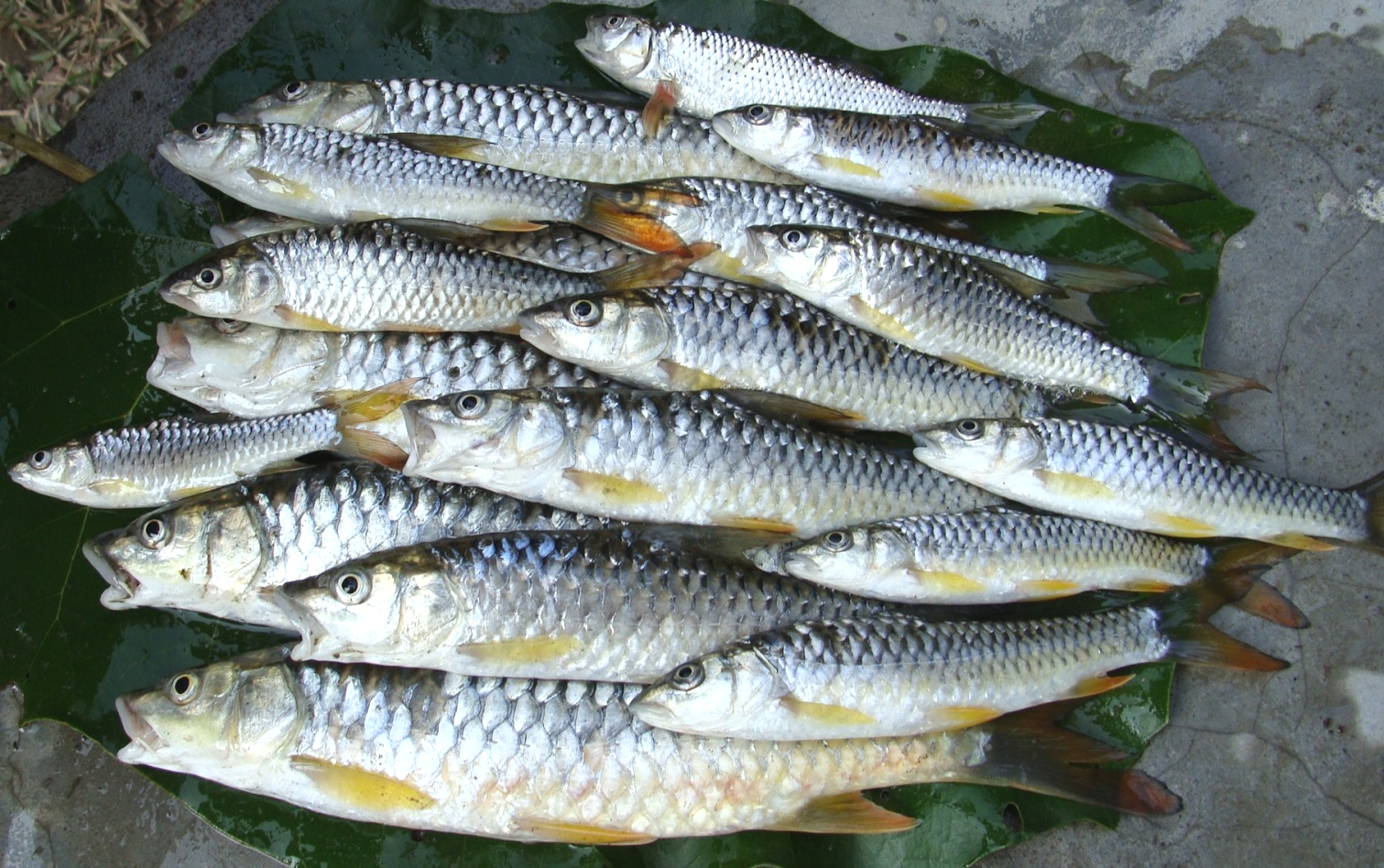
Based on the colouration of fins and body, Lot – 12, PART I is segregated into 3 species viz. Tor putitora, Tor tor and Tor chelynoides, characterized as under:
1 a
Body elongated and moderately compressed. Abdomen rounded. Head, larger than height of body. Snout pointed. Barbels prominent; 2 pairs – maxillary longer than the rostral ones. Mouth inferior, arched. Lips fleshy, continuous at the angles of mouth; lower lip produced backwards into a fleshy median lobe (mentum) and posterior labial groove uninterrupted. The undivided ray of the dorsal, osseous and smooth. Lateral line scales 22 – 28. Olive green along the back and head. Scales large hexagonal with dark bases; golden silvery above the lateral line and pale, silvery-white towards the belly. Fins lemon-yellow, the anal and caudal fins often tinged orange-red. Iris golden.
……………. Tor putitora [Yellow-finned Golden Mahseer]
PHOTOGRAPHS OF Tor putitora
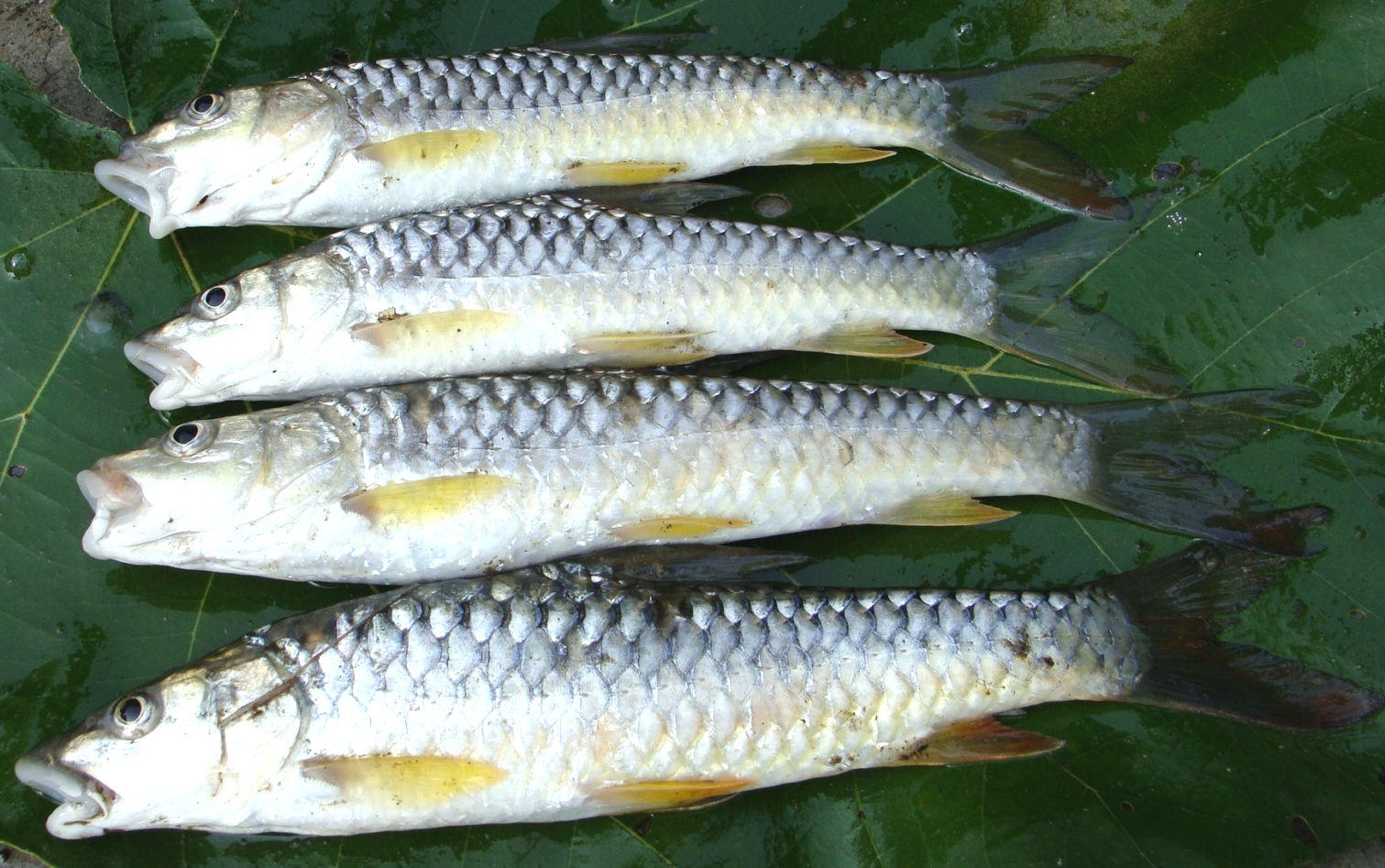
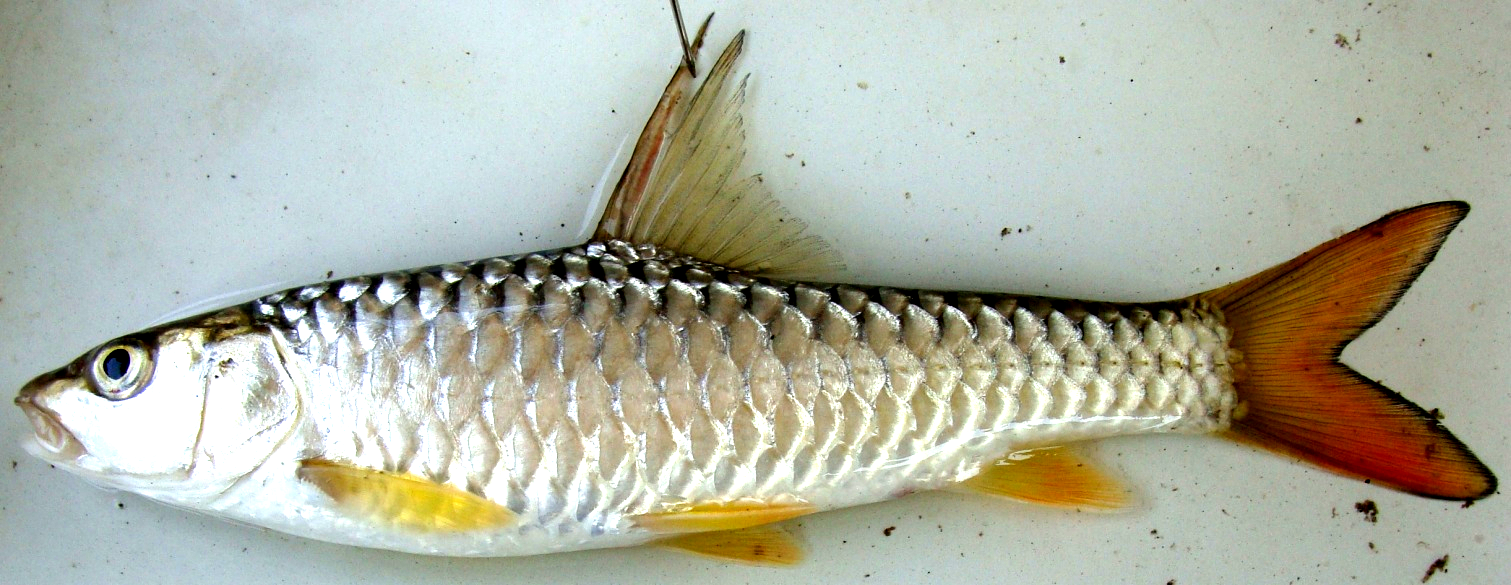
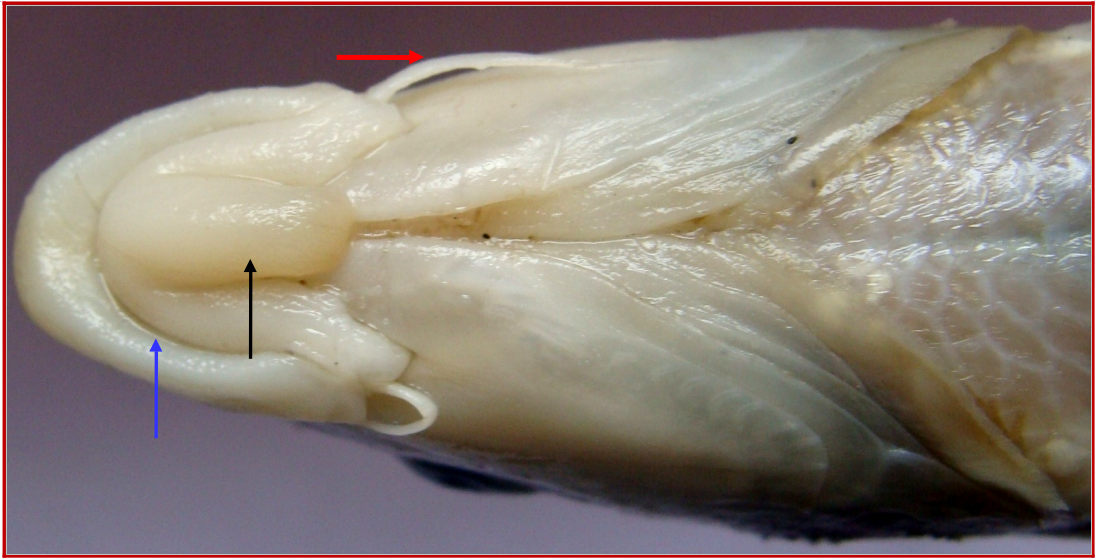
1 b
Body elongated and moderately compressed. Abdomen rounded. Head, shorter than height of body. Snout pointed. Barbels prominent; 2 pairs –the maxillary slightly longer than the rostrals or almost equal in length. Mouth inferior, arched. Lips fleshy, continuous at the angles of mouth; lower lip produced backwards into a fleshy median lobe (mentum) and posterior labial groove uninterrupted. The undivided ray of the dorsal, osseous and smooth. Lateral line scales 22 – 28. Olive green along the back and head. Scales with dark bases; golden silvery above the lateral line and pale, silvery-white towards the belly. Fins dark orange-red.
……………. Tor tor [Red-finned Mahseer]
PHOTOGRAPH OF Tor tor
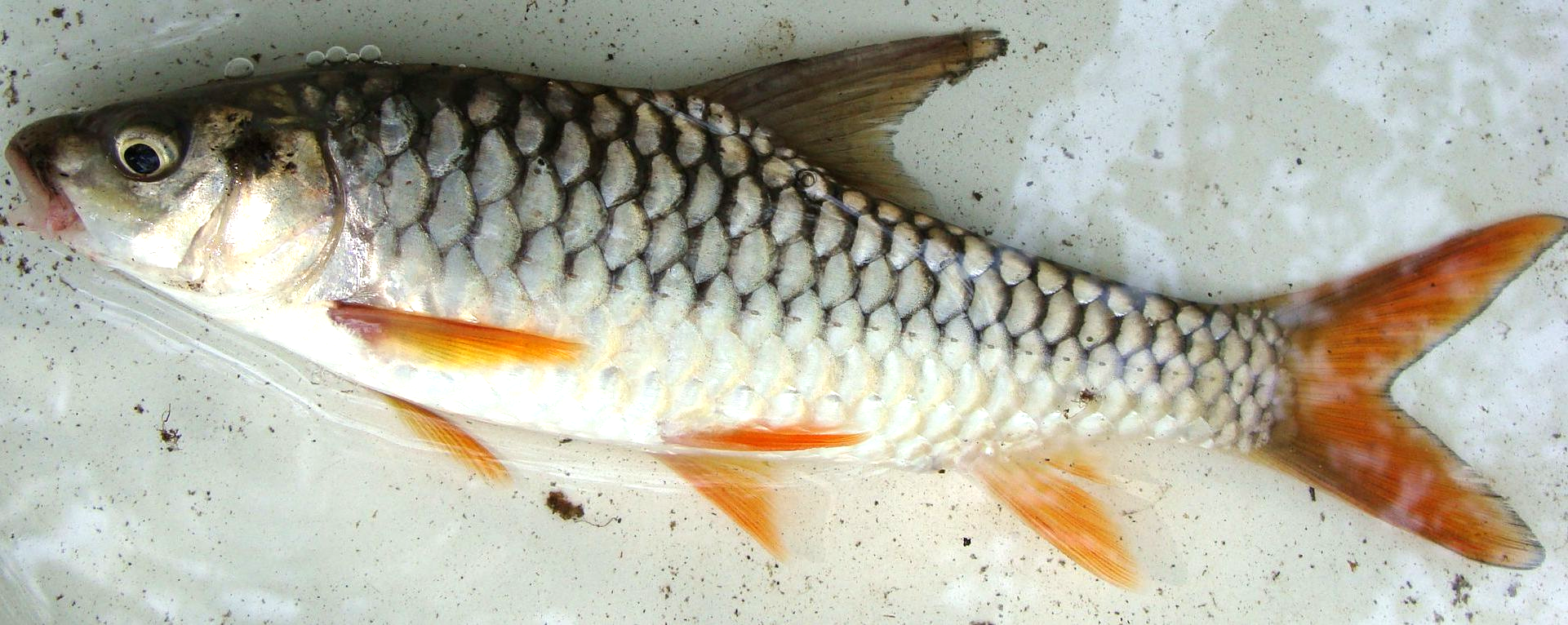
1 c
Body elongated and moderately compressed. Abdomen rounded. Head, shorter than height of body. Snout rounded. Barbels prominent; 2 pairs –the maxillary slightly longer than the rostrals or almost equal in length. Mouth inferior, arched. Lips fleshy, continuous at the angles of mouth; lower lip without a fleshy median lobe and posterior labial groove uninterrupted. The undivided ray of the dorsal, osseous and smooth. Lateral line scales 33 – 36. Body blackish-grey; bases of scales darkly pigmented; fine black dots extending on to the head also; black dots more concentrated along the lateral line, giving the appearance of a dark band; a diffused black spot is often noticeable at the caudal base covering 30th – 32nd scale. Fins whitish; dorsal fin rays pigmented black; caudal edged black; belly silvery grey.
……………. Tor chelynoides [Kala Mahseer]
[= Naziritor chelynoides, Puntius chelynoides]
PHOTOGRAPHS OF Tor chelynoides
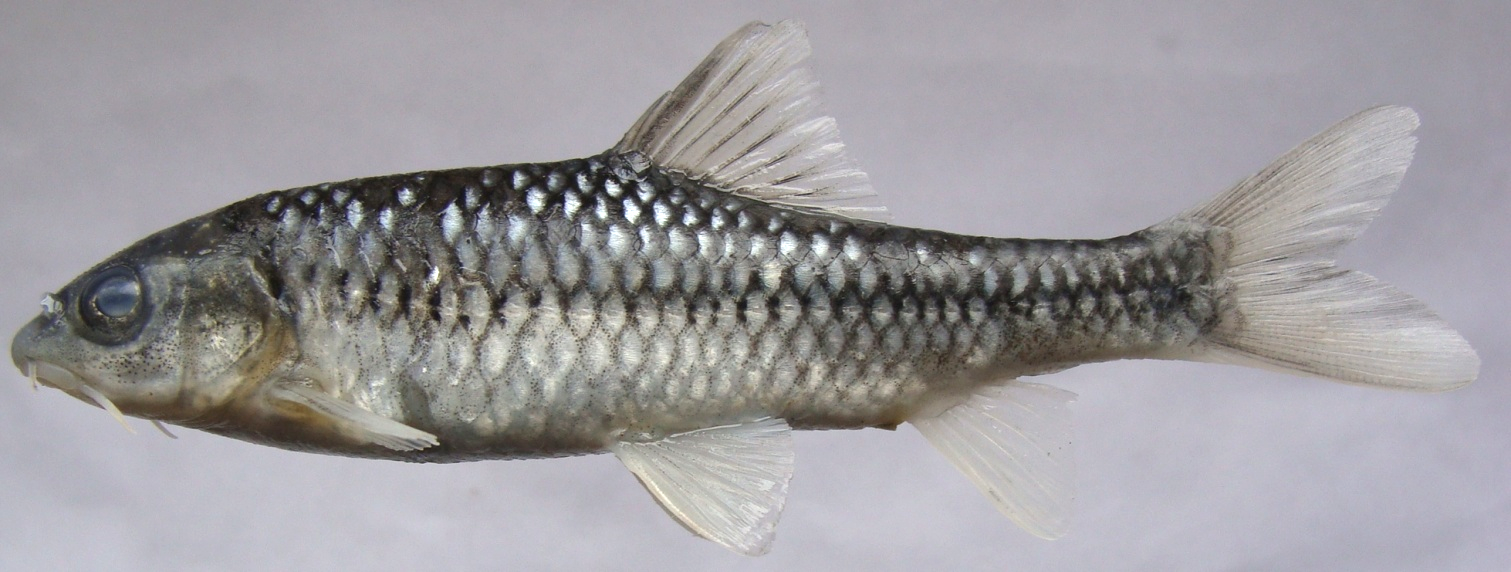
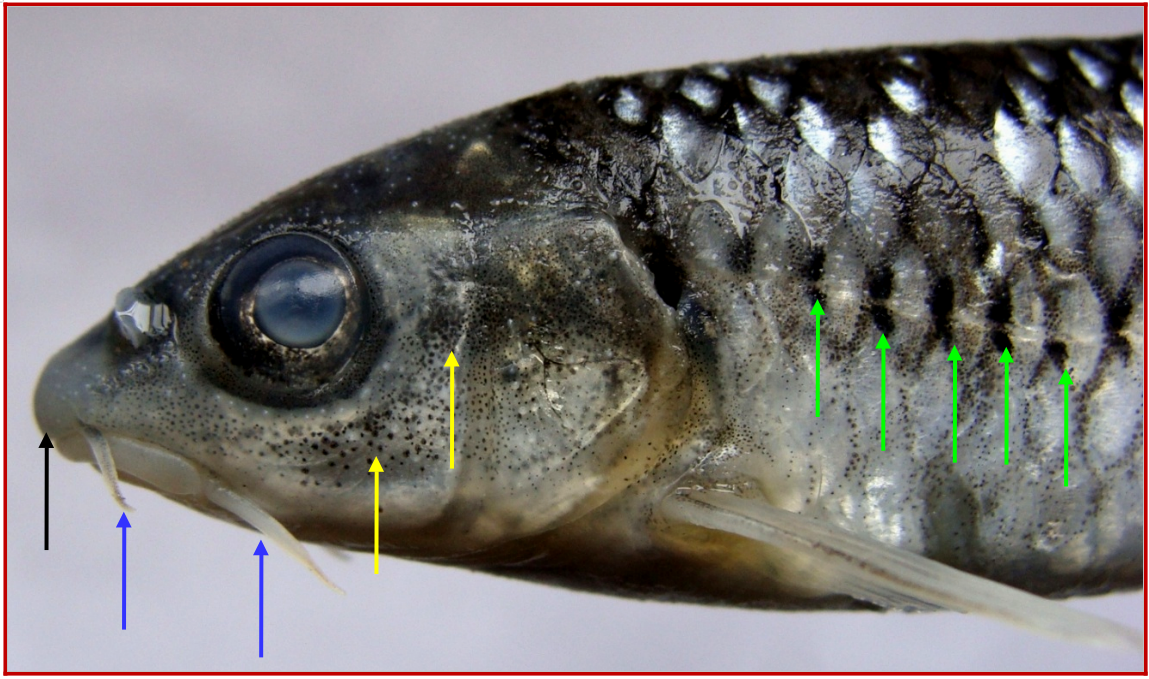
Tor chelynoides [Kala Mahseer]: Head region enlarged; showing rounded snout (black arrow); 2 pairs prominent barbels (blue arrows); blackish-grey body with bases of scales darkly pigmented; black dots more concentrated along the lateral line, giving the appearance of a dark band (green arrows); fine black dots extending on to the head also (yellow arrows).
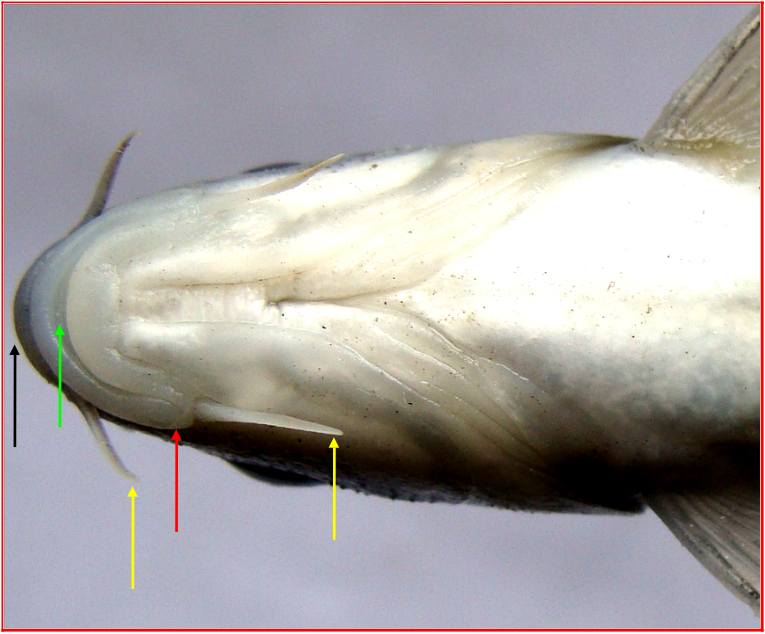
View of 2 live specimens of Mahseers [ Yellow-finned Tor putitora and Red-finned Tor tor] in gentle swimming mode.
2
The individuals, having moderate-sized scales with red spots along bases or reddish vertical line on each scale and pigmented spot (becoming prominent after preservation) covering 3rd – 5th scales along the lateral line, are identified as belonging to Genus Labeo and species dero [Family – Cyprinidae; Subfamily – Labeoninae; Minnows or Carps].

The sample 12.2 is characterized as under:
2 a
Body elongated, abdomen rounded. Head large with prominently tuberculated snout with deep transverse groove and without a lateral lobe. Lips thick; jaws with thick, inner horny coverings; the lower one semi lunar and finely fimbriated. Barbel 1 pair maxillary. Caudal fin deeply forked, the upper lobe being longer. Large-sized individuals are silvery, yellowish-ochre on the flanks and head, and greyish-ochre along the back; often a pigmented spot present, covering 4th – 5th scale along the lateral line. Scales with red spots along bases or reddish vertical line. Fins greyish, red-tinged. The young individuals are bright silvery grey when fresh.
…………… Labeo dero
[= Bangana dero]
PHOTOGRAPHS OF Labeo dero
 Labeo dero: Lateral view; large-sized individuals being silvery, yellowish-ochre on the flanks and head, and greyish-ochre along the back. Fins greyish and tinged red.
Labeo dero: Lateral view; large-sized individuals being silvery, yellowish-ochre on the flanks and head, and greyish-ochre along the back. Fins greyish and tinged red.

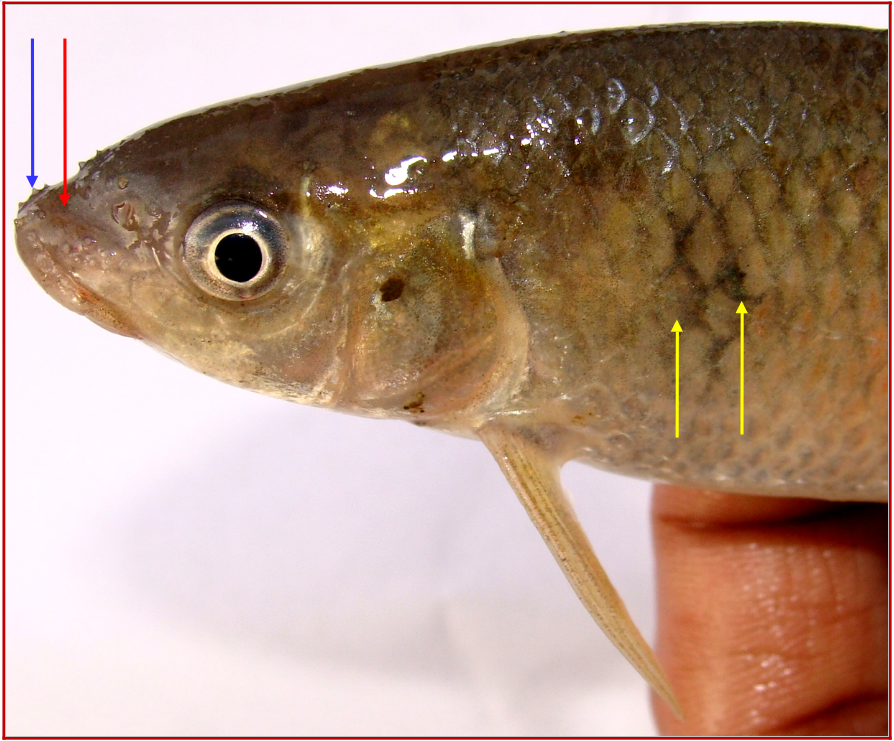 Labeo dero: Head and anterior region enlarged; showing prominently tuberculated snout (blue arrow) with deep transverse groove (red arrow) and a pigmented spot covering 4th – 5th scale along the lateral line (yellow arrows).
Labeo dero: Head and anterior region enlarged; showing prominently tuberculated snout (blue arrow) with deep transverse groove (red arrow) and a pigmented spot covering 4th – 5th scale along the lateral line (yellow arrows).
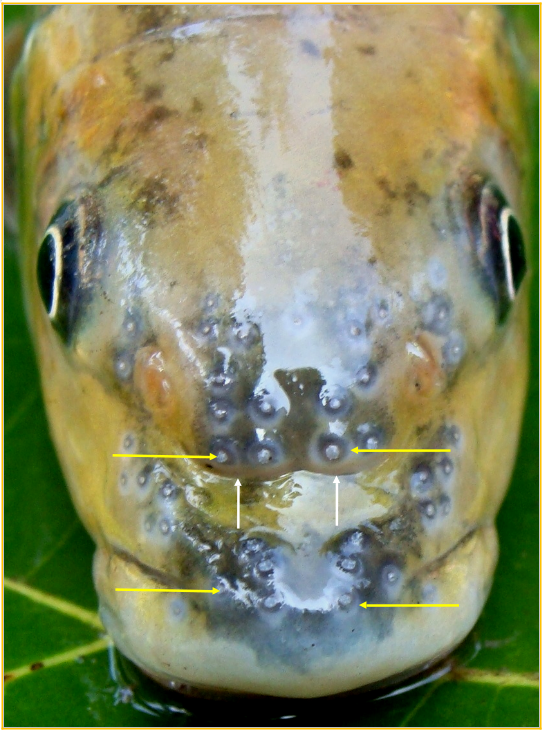
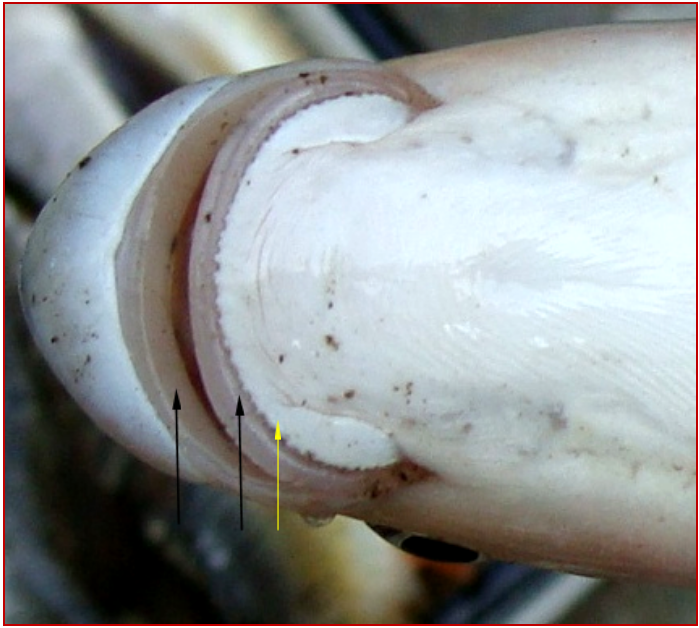
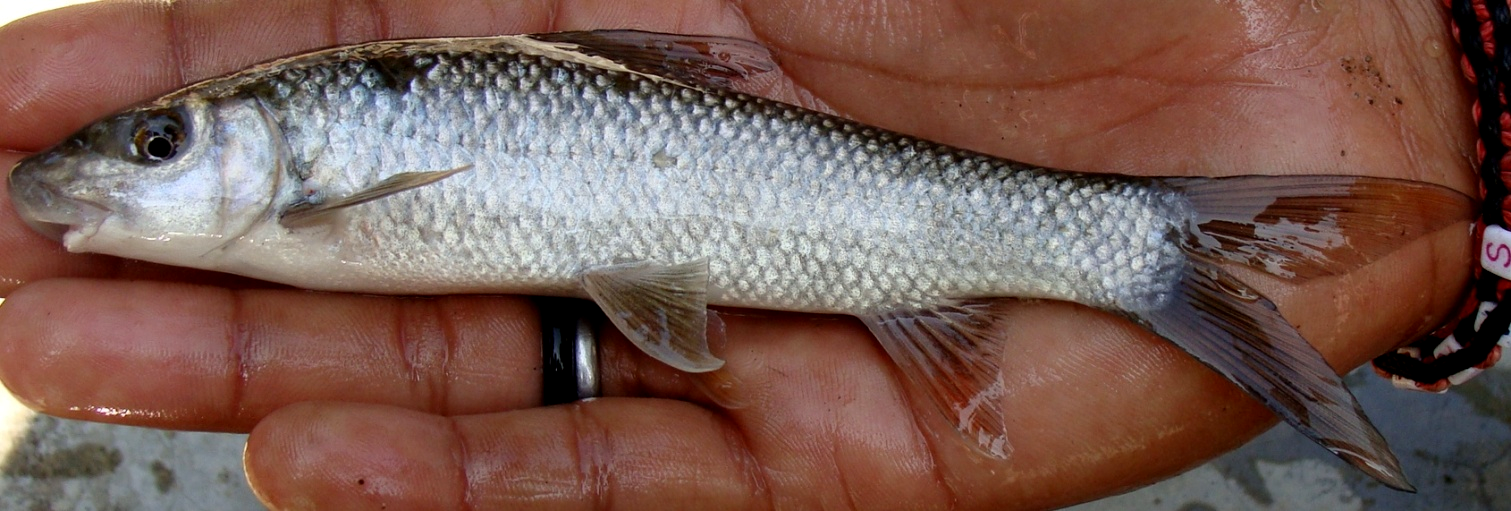
3
The individuals kept together in the field on account of having dark slate grey body with moderate-sized scales are found to belong to different Genera viz., Labeo and Crossocheilus[Family – Cyprinidae; Subfamily – Labeoninae; Minnows or Carps].
Of them, 2 dark slate grey samples having characteristic profile of snout (being blunt or rounded) and mouth in ventral view, are identified as 2 species belonging to Genus Labeo (3a and 3b).
Some other dark slate grey samples with irregular spots on the body are found to have prominently produced snout, overhanging the mouth with highly indented upper lip. These individuals (different from the Labeo sp.) are found to belong to Genus Crossocheilus (3c).

The characterization of these samples (Lot 12.3) is done as under [3a and 3b, Labeo sp. and 3c, Crossocheilus sp.:
3 a
Body elongated and laterally compressed; abdominal profile straighter; dorsal profile not steeply arched and caudal peduncular region more slender. Barbel 1 pair short, maxillary. Snout obliquely blunt, covered with fine tubercles (extending up to upper lip); often with a depression arising from below the eyes and joining in the middle of the snout. Upper labial fold along the angle of mouth more pronounced, with few fimbriations at the angle. When viewed ventrally, the lower lip shows prominent fimbriations (appearing like pleats). Whole body and fins dark slate grey to greenish-brown. Scales with dark spot at the bases and shot reddish. Area just behind opercular opening with a dark vertical streak.
…………… Labeo dyocheilus
PHOTOGRAPHS OF Labeo dyocheilus

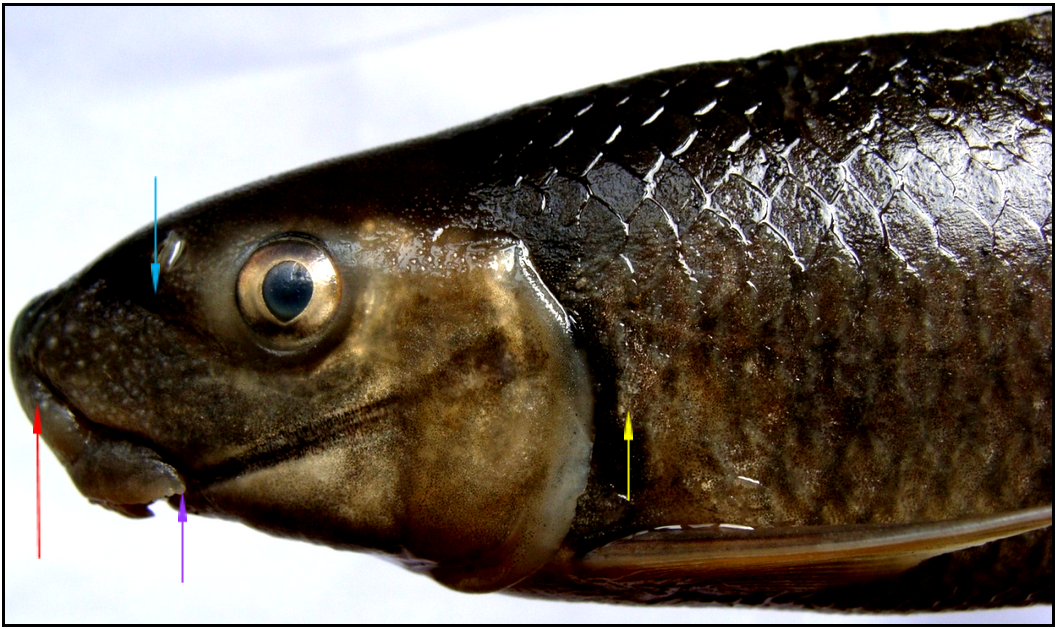
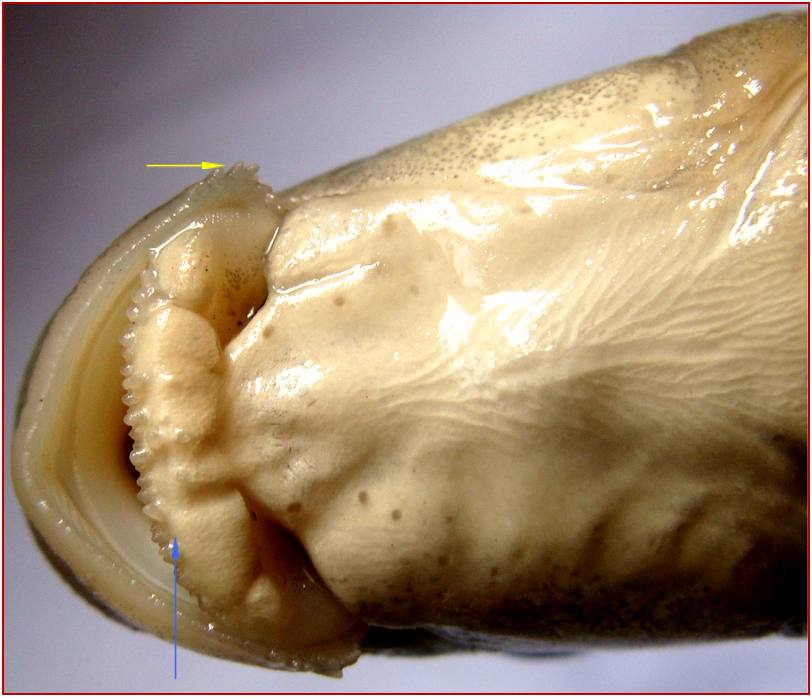
3 b
Body elongated and laterally compressed; abdomen rounded; dorsal profile steeply arched, caudal peduncular region thicker and shorter (as compared to L. dyocheilus). Barbel 1 pair short, maxillary. Snout rounded, smooth, covered with fine tubercles (extending up to upper lip); without a depression across the snout. Upper labial fold along the angle of mouth less pronounced. When viewed ventrally, the margin of lower lip appears smooth with occasional fimbriae. Whole body and fins dark slate grey to greenish-brown. Scales with dark spot at the bases and shot faint orange-red. Area just behind opercular opening with a faint dark vertical streak.
.
…………… Labeo pangusia
PHOTOGRAPHS OF Labeo pangusia

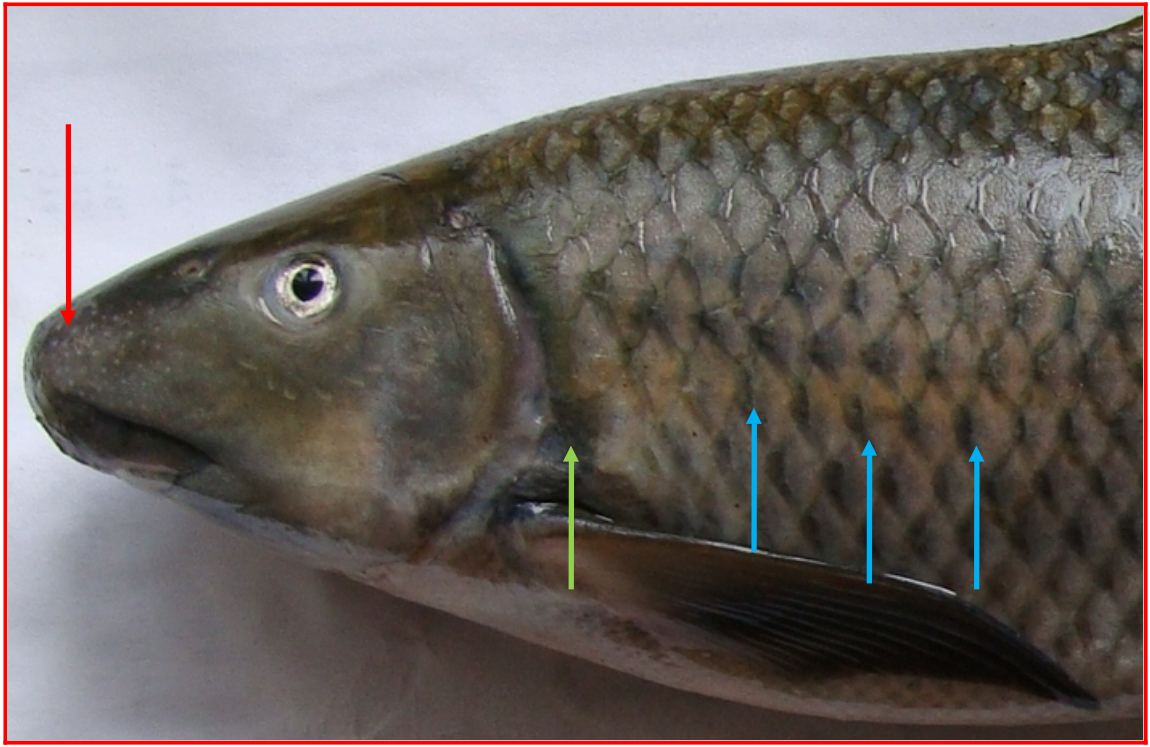
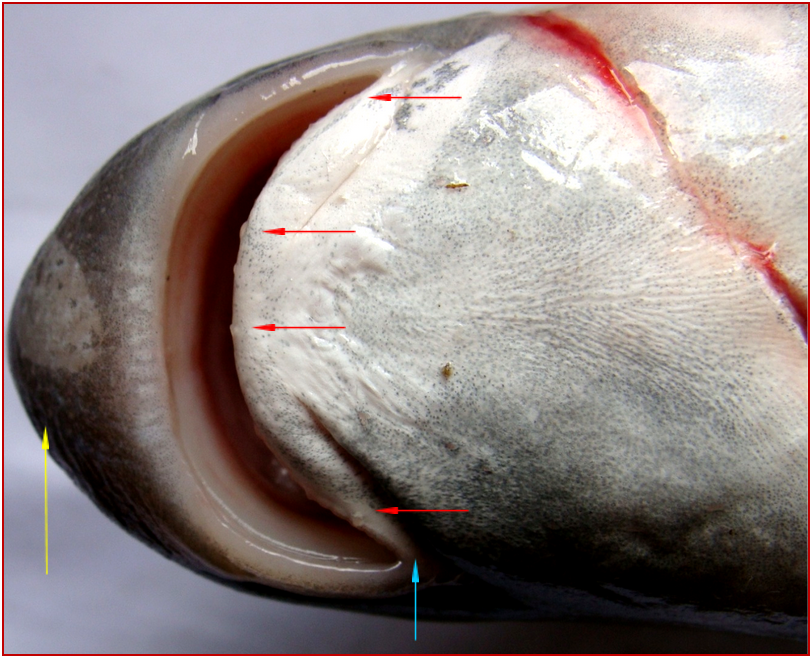 Labeo pangusia: Ventral view anterior region enlarged; showing rounded smooth snout (yellow arrow); less pronounced upper labial fold along the angle of mouth (blue arrow); smooth margin of lower lip with occasional fimbriae (red arrows).
Labeo pangusia: Ventral view anterior region enlarged; showing rounded smooth snout (yellow arrow); less pronounced upper labial fold along the angle of mouth (blue arrow); smooth margin of lower lip with occasional fimbriae (red arrows).
3 c
Body elongated, slender, more compressed (strap-like) at the caudal peduncular region. Dorsal profile arched up to base of undivided ray of the dorsal fin, thence gradually becoming straighter up to caudal base. Ventral profile more or less horizontal, straighter beyond base of the pelvics. Head small, somewhat flattened above. Eyes large, not visible from below ventral surface. Snout (= the rostral cap) obtusely rounded, smooth, with fine tuberculations and overhanging the inferior mouth; a frenulum connecting the upper lip with lower jaw present. Upper lip highly indented (as many as 16 – 17 indentations or fimbriae) [hence, Crossocheilus; Gk. krossoi = tassel + cheilos = lip]; each indentation with rounded tuberculations. Lower lip highly fimbriated and tuberculated, the fimbriations closely fitting into tips of indentations of the upper lip. Barbels 2 pairs; rostrals longer than the rudimentary maxillary ones, being hidden at the angle of mouth. Body dark silvery-olive-grey; darker along the dorsum and lighter along the abdomen. Scales shiny; each scale being with grey pigmentation; more pigmented, grey patches on the scales behind the dorsal base up to base of caudal. Fins pale-grey; caudal fin darker.
………………Crossocheilus latius
PHOTOGRAPHS OF Crossocheilus latius
Crossocheilus latius: Lateral view; showing elongated and slender body, more compressed (strap-like) at the caudal peduncular region; arched dorsal profile up to base of undivided ray of the dorsal fin, thence gradually becoming straighter up to caudal base; more or less horizontal ventral profile, straighter beyond base of the pelvics; small head, somewhat flattened above; obtusely rounded and smooth snout(= the rostral cap), with fine tuberculations and overhanging the inferior mouth; dark silvery-olive-grey body, darker along the dorsum and lighter along the abdomen; shiny scales; each being with grey pigmentation, more pigmented, grey patches on the scales behind the dorsal base up to base of caudal and pale-grey fins, caudal fin being darker.
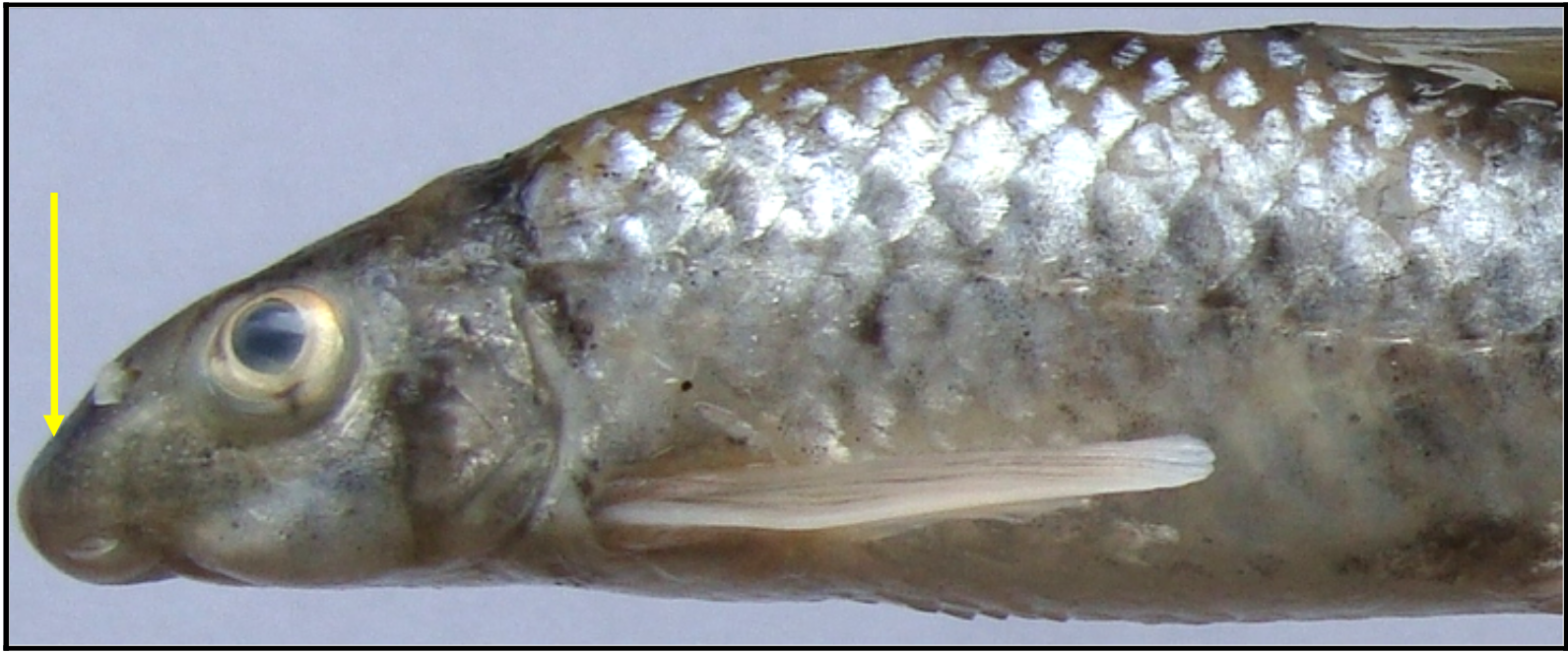
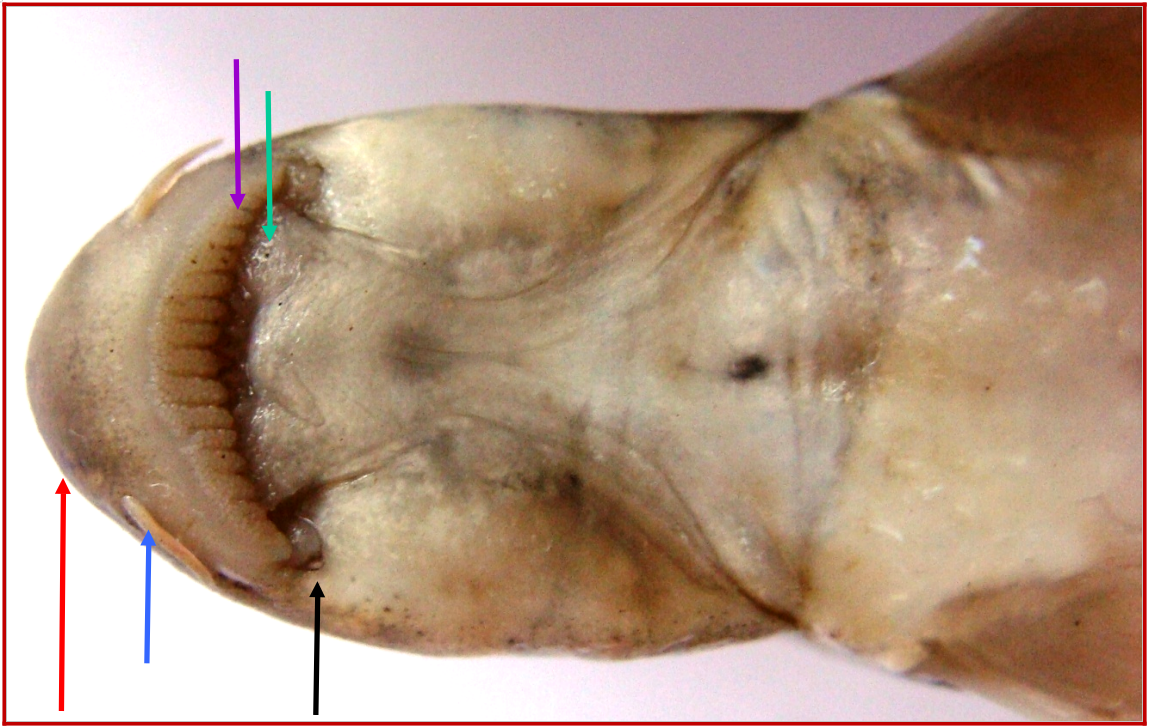
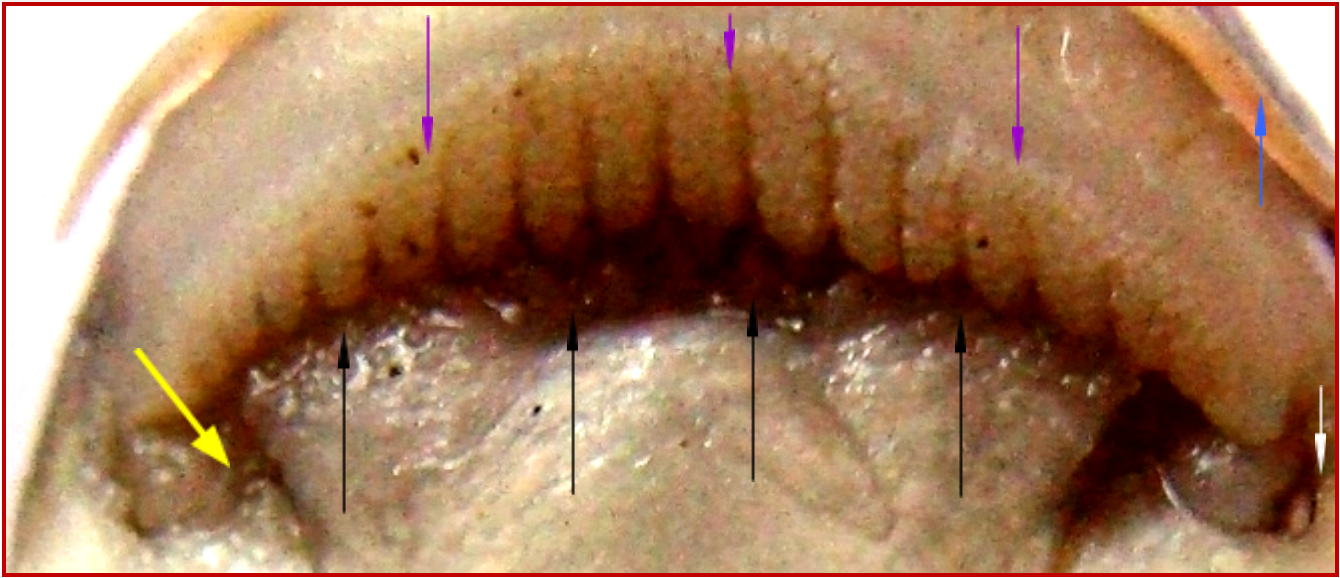
CLICK HERE TO VIEW SEGREGATION LOT – 12, PART II (Lot 12.4 – 12.6)
Schizothorax, Schizothoraichthys, Garra and Chagunius sp.
– An improvisation and compilation by Dr. S.K. Gupta
